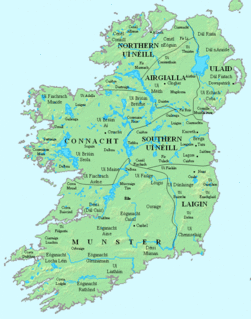Rónán mac Colmáin was a King of Leinster following Brandub mac Echach. There were two men named Rónán mac Colmáin active in Leinster in the early seventh century and confusion exists as to which one was king. Some later sources confuse the two Rónáns, but historian Francis John Byrne notes that the earliest sources do not.
Óengus mac Colmáin Bec was an Irish king. He was the King of Uisnech in Mide from 618 to 621. He belonged to the southern Uí Néill. According to the genealogies, he was a son of Colmán Bec, son of Diarmait mac Cerbaill. The later Caílle Follamain traced their descent through Óengus.
Colmán mac Cobthaig was a king of Connacht from the Ui Fiachrach branch of the Connachta. He was the first king of Connacht from the Ui Fiachrach Aidhne branch. This branch was descended from Eochu, the brother of Ailill Molt. According to the Book of Ballymote he was the grandson of Goibnenn mac Conaill (flor.537), the first Aidne king mentioned in the annals, but Rawlinson Genealogies name his grandfather as Gabrán.
Faílbe Flann mac Áedo Duib was a King of Munster from the Eóganacht Chaisil branch of the Eoganachta. He succeeded Cathal mac Áedo Flaind Chathrach of the Glendamnach branch in 628. He was the younger brother of a previous king Fíngen mac Áedo Duib. His sobriquet Flann meant "blood-red".
Loingsech mac Colmáin was a king of Connacht from the Ui Fiachrach branch of the Connachta. He was of the Ui Fiachrach Aidhne sept this branch and was the son of Colmán mac Cobthaig.
Muirchertach Nár mac Guairi was a possible King of Connacht from the Ui Fiachrach Aidhne branch of the Connachta. He was the son of Guaire Aidne mac Colmáin, famous in Irish sagas.
Fergal Aidne mac Artgaile was a King of Connacht from the Ui Fiachrach Aidhne branch of the Connachta. He was the grandson of Guaire Aidne mac Colmáin, the hero of many Irish sagas, and was the last member of this branch to hold the overlordship of Connacht.
Forggus mac Cellaig was a King of Connacht from the Uí Briúin branch of the Connachta. He was the son of Cellach mac Rogallaig, a previous king and brother of Domnall mac Cellaig. The sept of Uí Briúin Ai he belonged to was the Síl Cellaig of Loch Cime named for his father. He reigned from 742 to 756.
Dub-Indrecht mac Cathail was a King of Connacht from the Uí Briúin branch of the Connachta. He was the son of Cathal mac Muiredaig Muillethan, a previous king. He was of the Síl Cathail sept of the Ui Briun and ruled from 764 to 768.
Flaithrí mac Domnaill was a King of Connacht from the Uí Briúin branch of the Connachta. He was the son of Domnall mac Cellaig (d.728), a previous king. The sept of Uí Briun he belonged to was the Síl Cellaig of Loch Cime. He reigned from 773-777.
Artgal mac Cathail was a King of Connacht from the Uí Briúin branch of the Connachta. He was the son of Cathal mac Muiredaig Muillethan, a previous king and brother of Dub-Indrecht mac Cathail. He was of the Síl Cathail sept of the Ui Briun and ruled from 777 to 782.
Crimthann mac Áedo was a King of Leinster from the Uí Máil branch of the Laigin. He was the son of Áed Dibchine mac Senaig, a previous king. He would have succeeded sometime after the death of Rónán mac Colmáin. His brother Rónán Crach was possibly the Leinster king mentioned in the saga "Fingal Rónáin" and is also said to have been a bishop who was slain by Crimthann.
Crundmáel Erbuilc mac Rónáin was a King of Leinster from the Uí Cheinnselaig branch of the Laigin. He was the son of Rónán mac Colmáin, a previous king of the Sil Chormaic sept.
Suibne mac Colmáin was a King of Uisnech in Mide of the Clann Cholmáin. He was the son of Colmán Már mac Diarmato, also King of Uisnech. He ruled Uisnech from 587 to 600.
Máel Dóid mac Suibni was a King of Uisnech in Mide of the Clann Cholmáin. He was the son Suibne mac Colmáin and brother of Conall Guthbinn mac Suibni, previous kings. He ruled from 635 to 653.
Goibnenn mac Conaill was the first king of the Ui Fiachrach Aidhne mentioned in the annals. He was the great-grandson of the high king Nath Í.
Conall mac Máele Dúib, died 629, ) 14th King of the Uí Maine.
Marcán, 10th King of Uí Maine, died 556.
Dunchadh ua Daimhine, 23rd King of Uí Maine, died 780.


